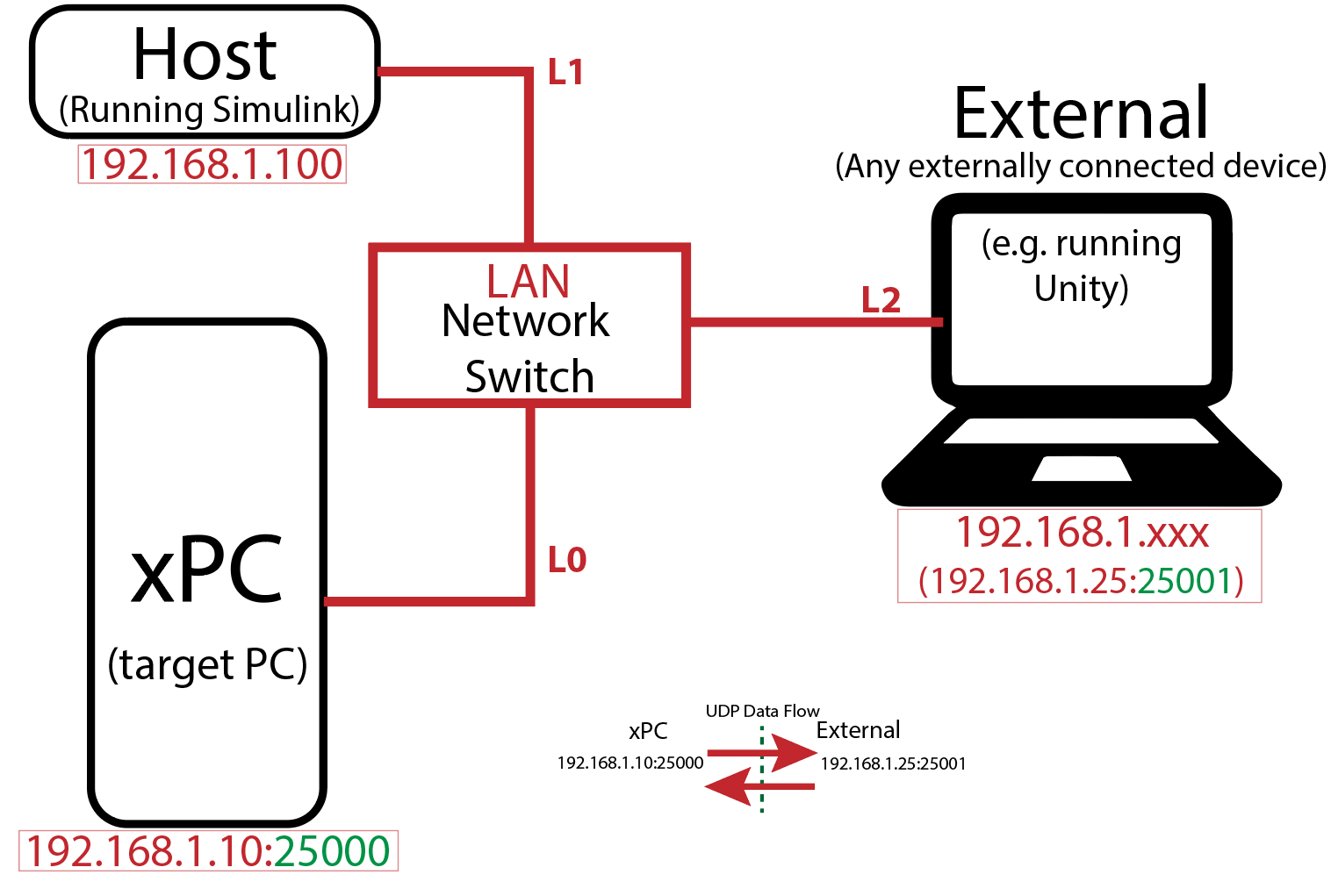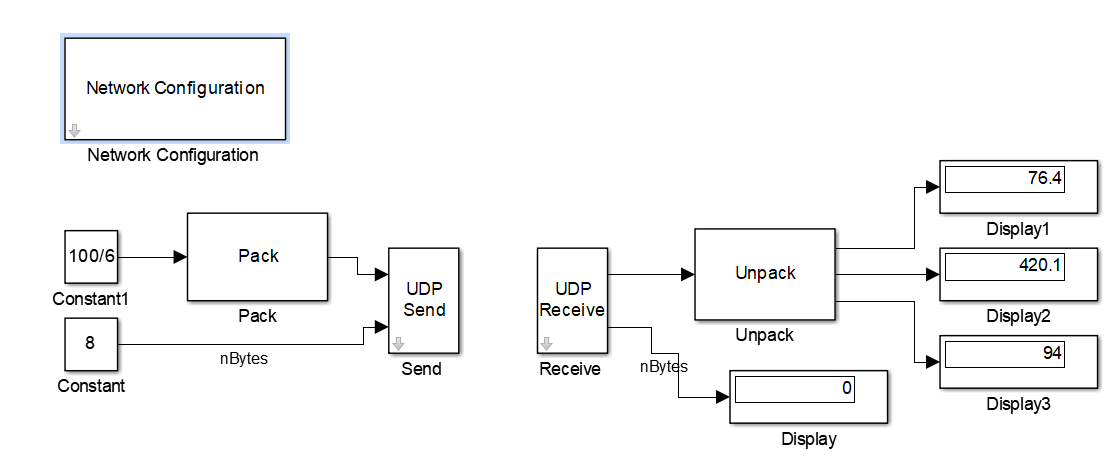User Datagram Protocol (UDP) is a commonly used communication protocol for the robotic devices at the MLN lab, such as the Lokomat, ARMin, BURT.
¶ Basics
- User Datagram Protocol Explained | UDP Datagram Communication |UDP | Computer Networks | Simplilearn
UDP is a communication protocol which speeds up transmissions by enabling the transfer of data before an agreement is provided by the receiving party, resulting in a connection that is [source]:
- low-latency
- loss-tolerating
- Potentially unreliable (no guarantee data reaches the target)
UDP packets come with a header, having 4 fields, each of which is 2 bytes:
- source port number: the number of the sender
- For more information on source/destination ports, see here.
- destination port number: the port to which the datagram is addressed
- length: the length in bytes of the UDP header and any encapsulated data
- checksum: used in error checking – its use is required in IPv6 and optional in IPv4.
This header is the reason you need to specify all this information when setting up a UDP connection. Through selecting the ports we select from which application (port) you want to receive data, as well as to which application (port) we want to send it.
If you want to know how to set up such a Host pc, see here.

We now removed the external PC, also running Unity on the Host-PC. This simplifies the network and works just as well, given the Host-PC is powerful enough to run Unity.
in this new setup, replace all the
25’s with100’s for the configuration settings.
Underneath, find a schematic of our network setup, for easy reference/debugging. All information below will be based on this schematic. We won’t talk in terms of client and server, because that’ll depend on from which device we will take our perspective.

When connecting a PC to the LAN network, you’ll need to quickly set some parameters for your IPv4 connection. In Windows:
- Go to settings, Network and Internet settings, find the ethernet connection you have connected to and click properties.
- Under IP settings, click Edit, & Set the IP to manual.
- Enable IPv4, and use the following settings:
- IP Adress:
192.168.1.25(can also be another, non-used, number after the last.) - Length of prefix of subnet:
24(for255.255.255.0subnet mask) - Default Gateway:
192.168.1.1 - (DNS server doesn’t matter)
- IP Adress:
¶ LokoFree
¶ Simulink
Find the xPC UDP blocks under Simulink Library Browser xPC Target/Real-Time UDP/
and the Pack/Unpack blocks under Simulink Library Browser xPC Target/UDP/
Example model underneath:

¶ Network Configuration
Network Configuration block (called xpcnwconfig) is used:
- Parameters:
- IP adress:
192.168.1.11(using the new, extra network card for dedicated UDP connection). - Subnet Mask:
255.255.255.0 - Gateway:
192.168.1.1 - Ethernet Driver:
Intel 8255x - PCI Bus:
1 - PCI Slot:
9
- IP adress:
¶ Sending data
Send block (called send) is used:
- Input: Byte stream (represented as a
uint8vector) - Parameters:
- IP adress to send to:
192.168.1.100 - Remote IP port to send to:
25001 - Use the following local IP port:
25000 - Sample time:
-1
- IP adress to send to:
Pack block (called xpcbytepacking) is used:
- Input: Any data you wish to send over UDP
- Parameters:
- Output port (packed) data type:
uint8 - Input port:
{'datatype','other data type', ... }
For example:{'int8'}to send over an integer value.
Other options:double, single, int8, uint8, int16, uint16, int32, uint32, boolean - Byte Alignment:
1
- Output port (packed) data type:
¶ Receiving data
Receive block (called receive) is used:
- Output: Byte stream (represented as a
uint8vector) - Parameters:
- IP adress to receive from:
192.168.1.100 - IP Port to receive from:
25000 - Output port width (number of bytes):
= 8*nDouble + 4*nSingle + 1*nInt8 + 2*nInt16 + 4*nInt32 + 1*nBool- depends on the what data you’re receiving (being sent by Unity).
- Sample time:
-1
- IP adress to receive from:
Unpack block (called xpcbytepacking) is used:
- Input: The data you receive (bytes in a uint8 array).
- Parameters:
- Output port (unpacked) data types (cell array):
{'datatype','other data type', ... }
Depending on what data types you are receiving. - Output port (unpacked) dimensions (cell array):
{1,N,...}
Depending on how many of each data type you are unpacking here. - Byte Alignment:
1
- Output port (unpacked) data types (cell array):
¶ Unity
In this guide, we are sending our data to and from Unity, using a UDP_CSharp C# Library found here. However, this can be any sort of device connected to the network and communinication over UDP.
TO DO: put link to C# library
- Parameters
- IP_SELF:
192.168.1.100 - PORT_SELF:
25001 - IP_DESTINATION:
192.168.1.11 - PORT_DESTINATION:
25000
- IP_SELF:
¶ LokoBasis (Treadmill)
We’ve also set up a UDP connection for the Treadmill.
¶ Simulink
Here, we can’t use the xPC Real-Time blocks, as they’re not compatible with the network card in the LokoBasis PC (also I8254x). Instead, we use the other UDP blocks, found under under Simulink Library Browser xPC Target/UDP/. We just need to receive data from here (the treadmill speed), so the example model would look like:

¶ Receiving data
Receive block (called xpcudpbytereceive) is used:
- Output: Byte stream (represented as a
uint8vector) - Parameters:
- IP adress to receive from:
192.168.1.100 - IP Port to receive from:
25000 - Output port width (number of bytes):
= 8*nDouble + 4*nSingle + 1*nInt8 + 2*nInt16 + 4*nInt32 + 1*nBool- depends on the what data you’re receiving (being sent by Unity).
- Sample time:
-1
- IP adress to receive from:
The Unpack block works the same as for the LokoFree, noted above.
¶ Unity
- Parameters
- IP_SELF:
192.168.1.100 - PORT_SELF:
25001 - IP_DESTINATION:
192.168.1.20 - PORT_DESTINATION:
25000
- IP_SELF:
¶ Problems / Troubleshooting
¶ xPC disconnecting from TCP/IP
When the xPC is sending out data over UDP, sometimes (note: not always…) it somehow takes priority over the TCP/IP connection making it unreachable. UDP communication will remain intact (although it will sometimes also crash).
Still don’t understand exactly what triggers this.
This does not happen when data is only received on the xPC.
If you set an end simulation time, the connection will break, until the model stops, at which point you can reconnect to the xPC via TCP/IP. If no end-time has been set, you may not be able to recover your connection, requiring a reboot of the xPC.
We fixed this by adding another NIC to the Lokomat target PC, and configuring UDP communication to run over that.
¶ Error 8 102 1
Lokomat shows error:
Error: Error 8 102 1
Error: --> EADDRINUSE
Error:
---
Error: System Halted
---
Not sure what caused it, but rebooting fixed it.